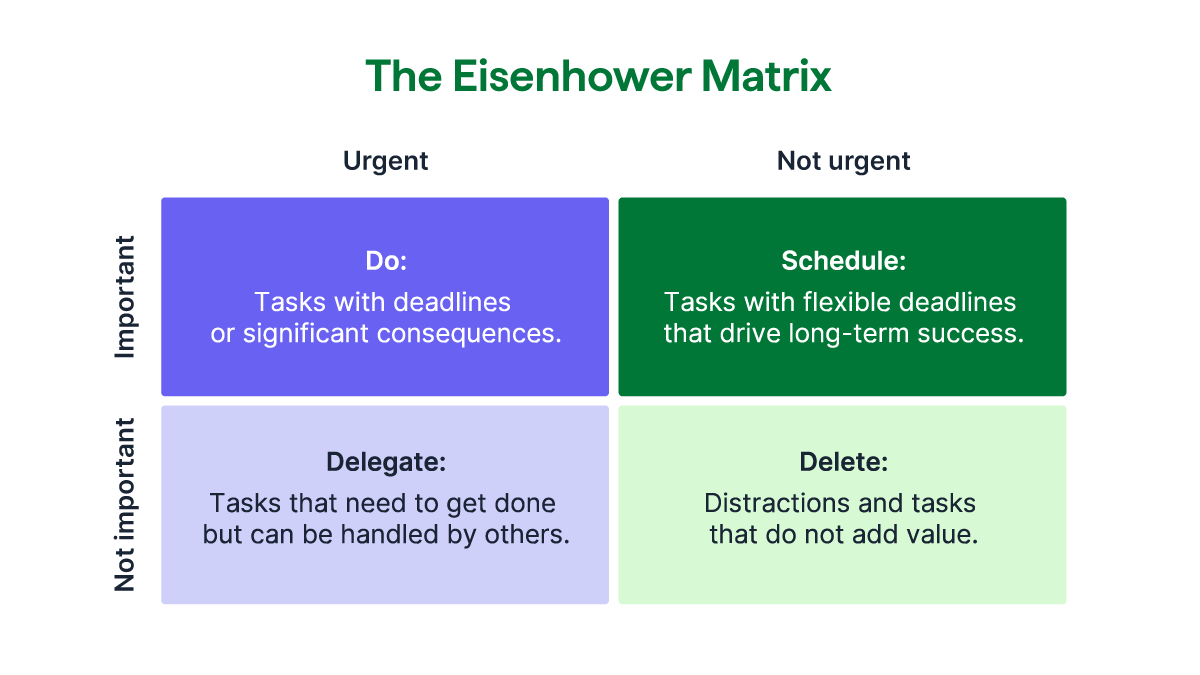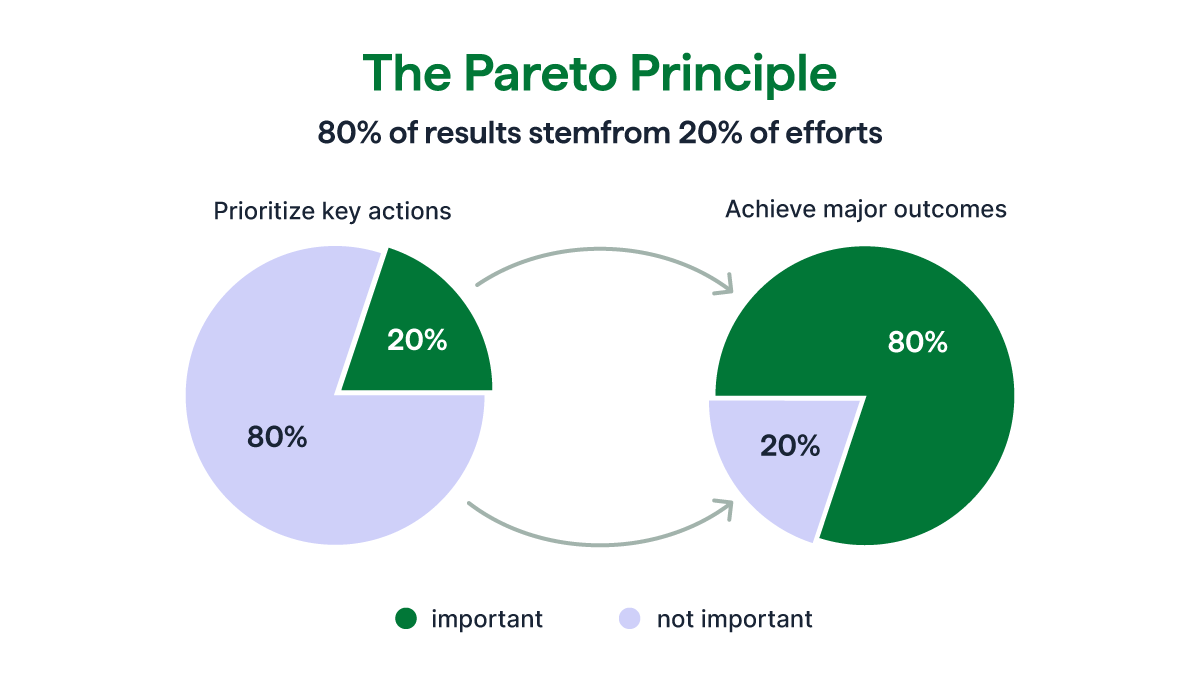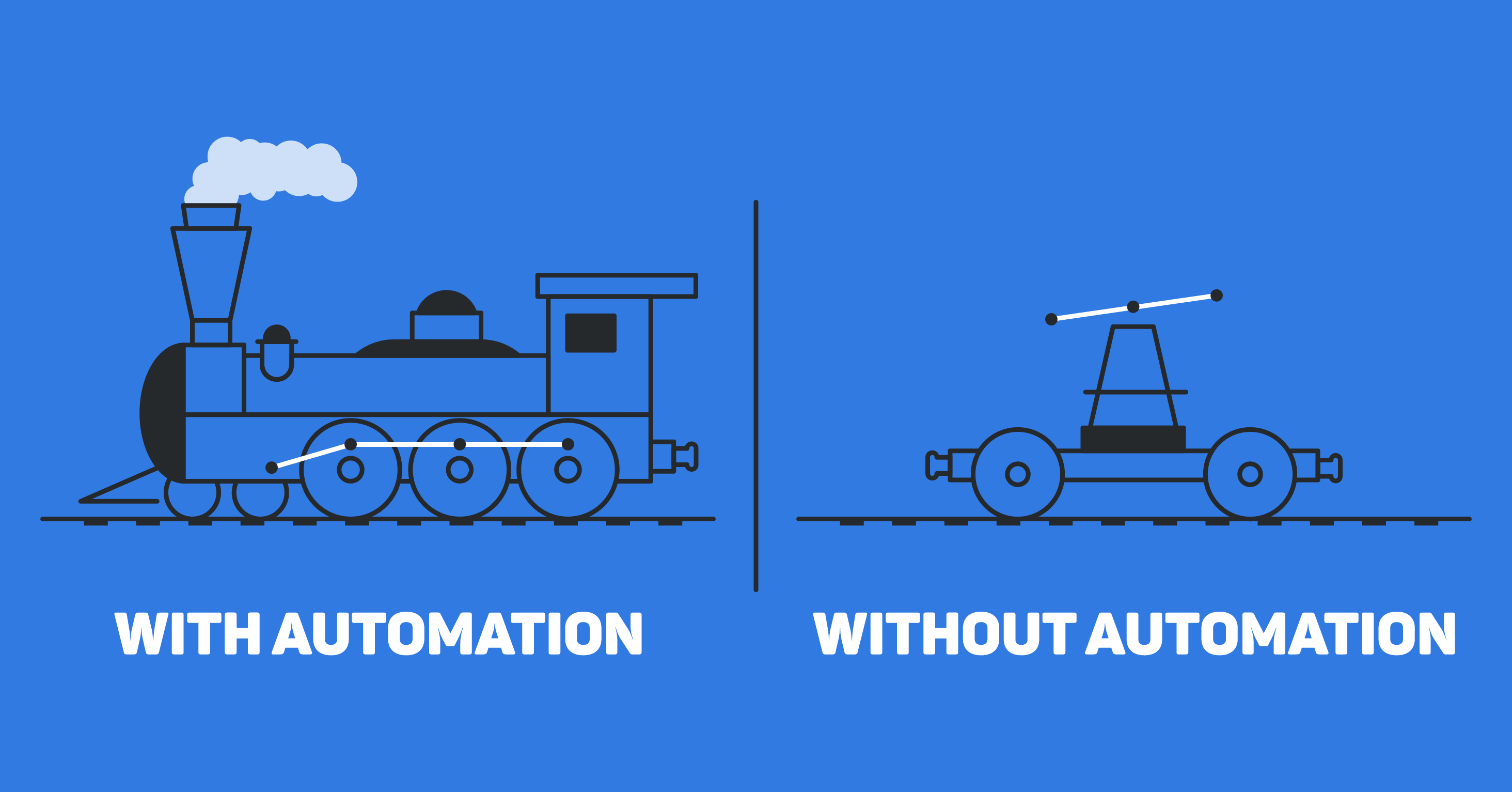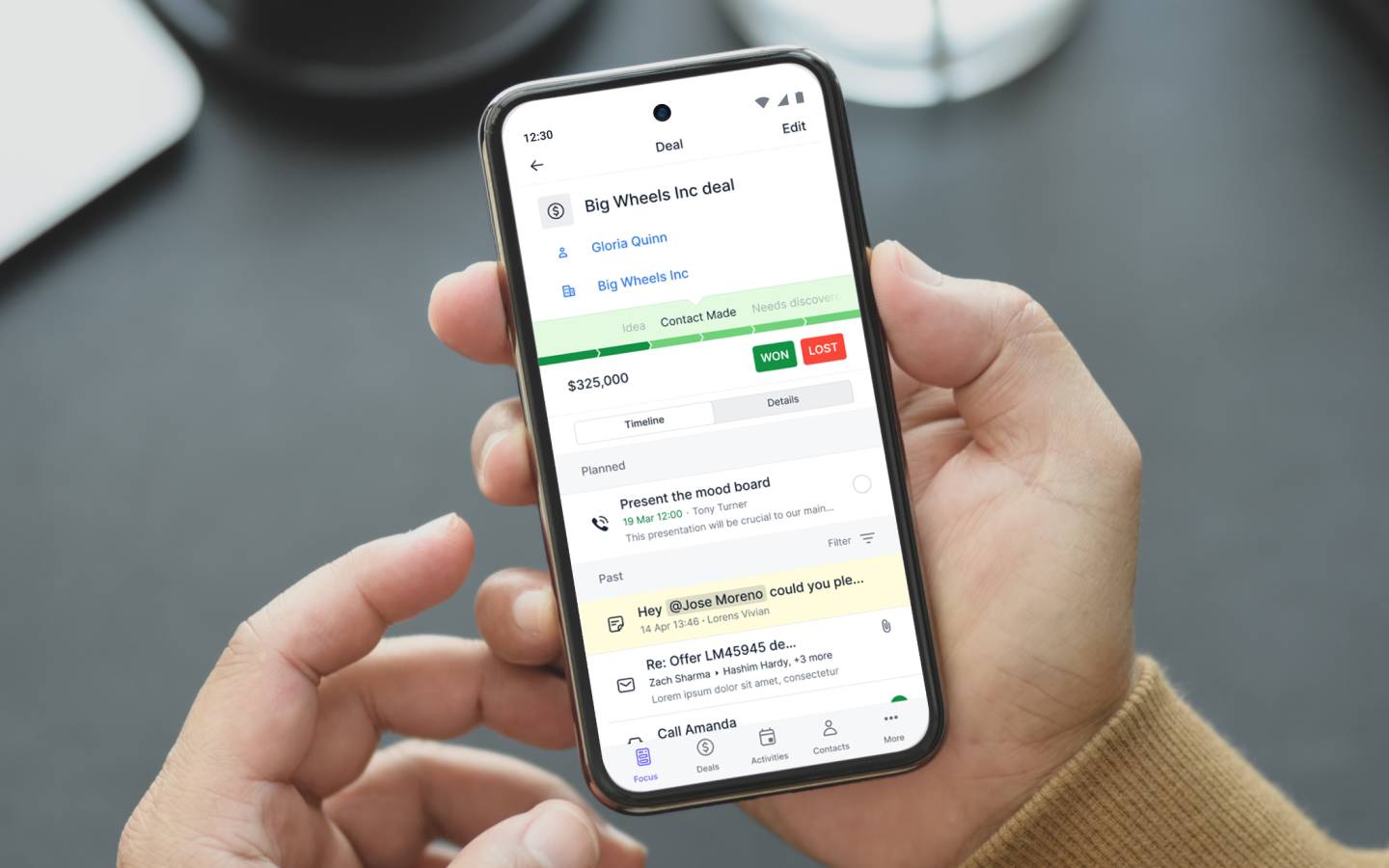Our view at Stack - Pipedrive is a robust CRM platform, offering automation, contact data collection, webhooks, AI-powered sales assistant, email communications, email marketing, and customisable sales pipeline workflows.
We all have the same 24 hours, so why do some people achieve more than others in the time they have? The answer: good time management.
Even if you’re naturally organized, you can implement specific tools and strategies to improve your productivity further.
In this article, we’ll explain time management and why it’s important. We’ll also provide nine data-backed strategies for maximizing your day’s productivity.
What is time management? Time management definition
Time management is your ability to plan activities and organize your time to ensure you spend an adequate amount on each task. It’s a desirable skill for those who want to be more productive at work, school and home.
Managing your time is easier said than done. For decades, people have been trying to do more with their days or weeks (e.g., setting goals or practicing self-discipline) by inventing various methods, some of which are even trademarked.
Imagine a sales manager who wants to balance their workload and complete more tasks. They may do so by dedicating tasks to a certain time of day – this is called time-blocking.
For example, they may set a time limit of one hour for catching up on any urgent business when they start work, such as important phone calls and emails. As the manager functions most highly in the morning, they set the next two hours aside for strategic planning.
To complete these tasks effectively, the manager closes their office door, limits their smartphone notifications and sets an “Away” status on their team communications app. They also use a scheduling tool to automate any meeting requests they may get during this time.
Bad habits and a culture of immediacy can make it tough. However, effective time management can be the difference between a productive day and one in which you feel like you’ll never have enough time.
The effects can also accumulate, giving you more or less time to spend on crucial tasks that impact you personally and professionally.
Time management comes naturally to some people. Others must adopt strategies to get the most out of their day and may wonder: why is time management important?
Recommended reading

5 sales productivity tips to supercharge your team
Why are good time management skills essential for productivity?
Good time management helps you consistently deliver high-quality work on time. It can help you hit personal and professional goals, leading to new opportunities and career growth.
For example, a sales rep who manages their daily tasks well ensures timely follow-ups, efficient client meetings and enough time to reach out to new leads. The rep exceeds sales targets, becomes a top performer and finds doors open to bigger accounts and promotions.
Here are four data-backed benefits for those needing more motivation to try time management techniques:
-
Reduced mental pressure. Planning and prioritizing tasks can reduce cognitive overload, helping you achieve more and unwind when the day’s over.
-
Enhanced strategic thinking. Microsoft research suggests almost two out of three people feel they lack the time and energy to do their jobs. As a result, they are 3.5 times more likely to struggle with innovation and strategic thinking. With more time to think, employees can be more creative and try new angles.
-
Improved workplace well-being. One study suggests effective time management may boost life satisfaction more than job performance.
-
Limited workplace stress. A Timewatch survey found that 91% of respondents agreed better time management reduces stress at work.
Time management skills can clearly impact various aspects of life, leading to greater efficiency, reduced stress and overall success.
Spend More Minutes Selling With These Time Saving Sales Hacks
Take control of your workday with these time saving sales tactics that will focus your meetings and calls, and help you tackle admin tasks.
9 time management tips to get more done in less time
There’s no shortage of advice on how to manage time better. However, time management can still be difficult because of psychological, environmental and practical factors.
Addressing those barriers and adopting some tried-and-trusted techniques can help you overcome time management difficulties and set yourself up for success.
Here are nine time management tips to help you gain time and hit goals.
1. Prioritize your daily tasks using the Eisenhower matrix
Named after US President Dwight D. Eisenhower, the Eisenhower Matrix breaks down specific tasks by their importance and urgency to more accurately prioritize them. His time management quote, “I have two kinds of problems, the urgent and the important”, coined the name of this strategy.
Note: While he said this in his 1954 speech, Eisenhower actually quoted university president Dr J. Roscoe Miller when he said the above.
The Microsoft report mentioned above also suggests that 68% of people don’t have enough uninterrupted focus time during the workday. The Eisenhower matrix can help you pinpoint and concentrate on your most important tasks.
Half of the people in one study who use the matrix feel their work is under control daily (the other half reported the same for four days of the week), making this a trusted tactic for many.
How to implement the Eisenhower matrix
There are four categories broken down into two columns (labeled “urgent” and “non-urgent”) and two rows (labeled “important” and “not important”).

The idea is that you should assign all tasks to a specific quadrant, then:
-
Complete important and urgent tasks immediately
-
Schedule non-urgent but important tasks for a later date
-
Delegate urgent but unimportant tasks to someone else
-
Remove non-urgent and unimportant tasks altogether
To use the Eisenhower matrix, write a to-do list, then use color-coding to prioritize tasks into their quadrants (e.g., red means urgent, green means remove). Eliminating unnecessary tasks first can also help you target your focus and ensure you don’t feel overwhelmed.
2. Time-block with the Pomodoro technique but experiment with length
The Pomodoro technique is a time-blocking exercise developed by student Francesco Cirillo. When organizing his university study schedule, he used a tomato-shaped kitchen timer to help him focus on one task at a time.
Narrowing your focus and working in short bursts can help maintain higher concentration levels and reduce the chance of becoming mentally exhausted.
The original technique dictates that time blocks (or “Pomodoros”) should be 25 minutes, but that may not be the optimal length of time for you. Instead, experiment with shorter or longer blocks until you find a limit that works for you.
How to implement the Pomodoro technique
Find a standalone timer (of any shape) or use your smartphone to track time blocks. Then try the Pomodoro technique like so:
-
Choose a task
-
Set a timer to your chosen limit
-
Work on that task uninterrupted until the timer goes off
-
Take a short break
-
Take a more extended break every four cycles
Ideal time-blocking lengths can vary depending on the person or task, so consider starting with a shorter block (e.g., 10 minutes) and increasing it as you find you can focus for longer.
According to neurobiologist Andrew Huberman, the ideal mental and physical exertion bouts should be around 90 minutes. Based on this advice, you may want to take a break at least every hour and a half.
3. Limit multitasking by combining Pareto and Getting Things Done
The Pareto principle (or 80/20 rule) states that around 80% of consequences are spurred by 20% of causes. Understanding the concept helps you prioritize the most critical tasks with the greatest impact.
Italian economist Vilfredo Pareto observed the 80/20 rule in different areas of his 19th-century life. For example, 20% of the population owned 80% of the land, and 20% of its plants bore 80% of the fruit.

In business, a well-known adage states that 20% of customers create 80% of a company’s profits, and 80% of results come from 20% of actions.
PwC research suggests that a significant portion of the time we spend on routine tasks is inefficient, so you may need to focus more of your efforts on areas that help you maximize your output.
Start by identifying tasks that will impact your business or team the most, then focus on completing them. You can do so using the Getting Things Done (GTD) method.
How to use the Getting Things Done method
The GTD method (developed by David Allen in the early 2000s) aims to organize and store all tasks in one external source. This allows you to focus on the next task without trying to keep track of everything in your head.
Even if you don’t think you’re multitasking, your brain is always subconsciously shuffling through your mental to-do list to ensure you don’t forget anything.
The GTD method removes this pressure so you can work more efficiently. Here are the five steps to effectively get things done:
-
Capture everything. Write down any task or to-do that crosses your mind in one “Inbox” (e.g., Pipedrive’s Notion integration or any digital tool you like).
-
Clarify. Define everything you’ve captured by starting with a verb (e.g., “Review user feedback”) and any other context (e.g. when the task is due).
-
Organize. Sort everything into the appropriate place with an organizational structure (e.g., by priority level).
-
Engage. Start getting things done.
-
Review. Reflect on your list at the start and end of the day to update it accordingly.
Couple the Pareto principle with the GTD method to free up your mind and focus on the tasks that matter most.
Recommended reading

Which sales tasks should you automate?
4. Experiment with time management apps to hinder procrastination
Time management apps help individuals and teams manage their time more effectively. Valuable features can include planning, organizing, tracking and optimizing time usage to enhance productivity and efficiency.
Experimenting helps you find those that suit your personal preferences and work style the best. Doing so will increase your likelihood of sticking with them and staying in control of your time in the long term.
Apps like these can also help increase awareness of procrastination habits to hold yourself accountable. Doing this enough can even motivate behavior changes over time.
How to use time management apps to stay productive
With so many time management apps on the market, you can narrow down those that work for you using the jobs-to-be-done (JTBD) framework. Figure out what you want to accomplish in a given situation and find a time management tool that solves that problem.
For example, you can track your time on each task or improve your wider project management workflows.
Here are some of the best time management apps with valuable functionalities:
-
Asana handles company-wide work management to help teams collaborate and ensure projects stay on track
-
Todoist offers smart task management and to-do lists to keep you organized and boost personal productivity
-
Timely automates time tracking to provide accurate insights into how you spend your days
-
GoalsOnTrack helps you set SMART goals (specific, measurable, achievable, realistic and time-based) to achieve personal and professional milestones
You can also use customer relationship management (CRM) tools like Pipedrive. Pipedrive’s many features, add-ons and integrations can save you and your team time on a wide variety of activities.
For starters, you can automate many time-intensive parts of your sales process and automatically notify team members when statuses change.
Pipedrive’s AI Sales Assistant provides real-time, AI-powered insights and recommendations to help you boost sales efficiency and close more deals.
The Projects add-on streamlines project management for frictionless workflows and timely completion.
You can also access Pipedrive via a mobile app to stay productive on the go.

5. Give your tasks a “why” to add meaning and motivation
Giving a task relevance to your life (or the lives of those you care about) can motivate you to achieve it.
For example, you may need to arrange 10% more sales meetings to hit your quota.
Adding a “why” to this task could look like this:
Arranging 10% more meetings and hitting my quota will earn me a bonus that allows me to take my husband and kids on a dream vacation.
A growing body of research suggests that feeling like you’re improving other people’s welfare with a task makes it more meaningful.
For example, “If I do this now, then my team could surpass their target for the week”. The resulting feeling can lead to heightened well-being for workers and greater productivity for organizations.
You can apply this method to your work or personal goals to compel you to achieve them.
How to upgrade your to-do list with “why”
When a task lacks any greater meaning, it’s harder to feel motivated to complete it. Adding context allows you to highlight the reason(s) behind each task and create a sense of purpose to see it through.
Write your to-do list when you have a quiet moment (at the start of the month or the evening before), then add a “why” next to each one.
Here are some examples:
-
“Identifying top-performing strategies in weekly sales reports will help us meet quarterly targets and fund team growth, freeing up my Sundays to coach my son’s soccer team”
-
“Coordinating a training workshop on the latest CRM system will streamline our sales process and reduce admin, which means more relaxed evenings with my wife”
-
“Developing a targeted outreach campaign for high-value prospects will help us secure a deal and give me more time to volunteer at my local community center”
Even if a task already has a company benefit, you can make it more meaningful by explaining how it impacts you personally.
6. Align rewards for task completion with the effort you put in
Rewarding yourself when you complete a task leads to immediate gratification (a positive emotion). Doing this enough can reinforce the behavior and train your brain to build a productive habit.
According to Dr. Ralph Ryback:
Knowing that a reward awaits when you complete a task can also make starting and finishing them more appealing. Therefore, you can become less reluctant over time.
How to reward yourself for task completion
As soon as you achieve a key task, celebrate with something that helps keep you motivated and enjoying the process.
Rewards for daily tasks don’t have to be anything big. For example, you may reward yourself with a:
-
Coffee break
-
Walk around the block
-
Snack (e.g., a candy bar or smoothie)
-
Hobby you enjoy (e.g., drawing or playing an instrument)
-
Chat with a friend or family member
It’s also important to align the reward size with the effort required to complete the task. More significant tasks can have bigger rewards (e.g., a spa day or weekend getaway), while easier tasks get smaller rewards.
Keeping rewards for daily tasks moderate ensures they retain their effectiveness and bigger ones remain special. You can also vary your regular rewards to keep things interesting.
7. Get comfortable asking for help when necessary
Sometimes, we need to ask for help to manage our workload and feel less overwhelmed. However, we may not do so because we are too self-reliant, too proud or we fear rejection – a feeling that activates the same regions in the brain as physical pain.
Self-reliance (e.g., thinking independently and embracing your individuality) is a psychological trait that can lead to happiness, but it can hinder you when you use it to shoulder every challenge on your own.
If your lack of skill, knowledge or direction causes poor time management, it’s time to get comfortable asking for help.
How to ask for help at work
You likely have a wealth of knowledge and expertise among your colleagues and people you know. Tap into these resources by asking for help and using your team’s collective wisdom to find solutions and improve efficiency.
If you’re not used to doing so, here are some tips to help:
-
Start by asking for help on smaller, less intimidating tasks to build your confidence gradually
-
Rehearse what you want to say before approaching someone to reduce anxiety
-
Find a time when the person you want to ask doesn’t look too busy or stressed to increase the chance of them being available to help
-
Inspire reciprocity and a cooperative reputation by helping other team members first
-
Experiment with different ways of asking politely (e.g., “Can I share some ideas with you for five minutes, please?”) to see which gets the optimal reaction
Whenever you receive any form of help, remember to show gratitude. Doing so leads to a positive interaction and can encourage others to continue offering assistance in the future.
8. Turn off distracting smartphone notifications
For many people, smartphones are crucial for work and home life. However, notifications can interrupt concentration and make it challenging to stay focused.
Recovering focus every time you’re interrupted takes time and effort, which can decrease overall productivity.
Notifications contribute to the distractions that lose US workers an average of 6 hours and 33 minutes weekly. Even when off, having our cell phones near us is enough to reduce cognitive capacity.
Even if you can’t turn off your cellphone completely (e.g., if you’re a parent or guardian), you can limit the apps that distract you.
How to limit smartphone distractions
Notifications can make you react impulsively (e.g., start a conversation with a friend or browse an online store’s products). Removing these potential distractions can help you think more clearly and make more thoughtful decisions.
Here are some tips for limiting smartphone distractions:
-
Turn on airplane mode and move it out of sight (e.g., in a drawer)
-
Switch to “Do Not Disturb” mode (or a similar mode your cellphone offers) and put it in another room. If someone calls three times, they can bypass this, ensuring emergencies still get through.
-
Customize a “Work” focus mode to adjust notification settings for individual apps (e.g., you may turn off TikTok but allow text messages from certain contacts if your provider allows)
-
Turn off push notifications and configure apps to fetch data manually or at longer intervals so there’s less chance of something interrupting you
Avoiding messages and notifications may make you feel anxious at first, but blocking out an hour or two of focused time without non-work distractions can increase productivity and improve mental health.
9. Schedule the right kind of breaks to maintain a healthy work-life balance
Everyone has a limited pool of physical and cognitive resources. Short, regular breaks can help you recharge and stay focused, but they have to be the right kind.
For example, pausing work for 10 minutes to catch up on your social feeds can actually make you more tired in the long run.
Studies suggest that brief breaks vastly improve focus. However, scrolling through social media can lead to emotional exhaustion.
Reading and watching endless posts, updates and news can overwhelm your brain with information and make you feel more tired than refreshed. It’s also much easier to lose track of time as there’s always something new to see.
How to schedule regular breaks
Spending breaks on your cell (especially if it’s been in another room) can be tempting, but there are more effective ways to spend your time.
Instead of swapping one screen for another, try these ways to spend your free time:
-
Have a snack, glass of water or coffee while sitting outside
-
Stretch, do yoga or close your eyes and practice mindfulness
-
Read a few pages of a book
-
Spend a few minutes organizing your workspace
-
Take a short walk
Everyone’s rhythms are different. The more you work with yours, not against it, the more productive you’ll be.
You may get more done first thing or be more productive after lunch. Whatever your body’s rhythm, focus on taking shorter breaks when you’re at your best and longer breaks when you need more recovery/processing time.
Final thoughts
These time management methods can help anyone who struggles to find enough time to achieve their daily, weekly or long-term goals.
Managing your time doesn’t just lead to more productive days. It reduces stress levels and avoids burnout.
If you’re an owner or sales leader who wants to optimize the amount of time spent selling your product, try Pipedrive’s CRM. Use it to automate nearly every step of your sales process so you can spend more time on higher-priority tasks.
If Pipedrive is of interest and you'd like more information, please do make contact or take a look in more detail here.
Credit: Original article published here.
